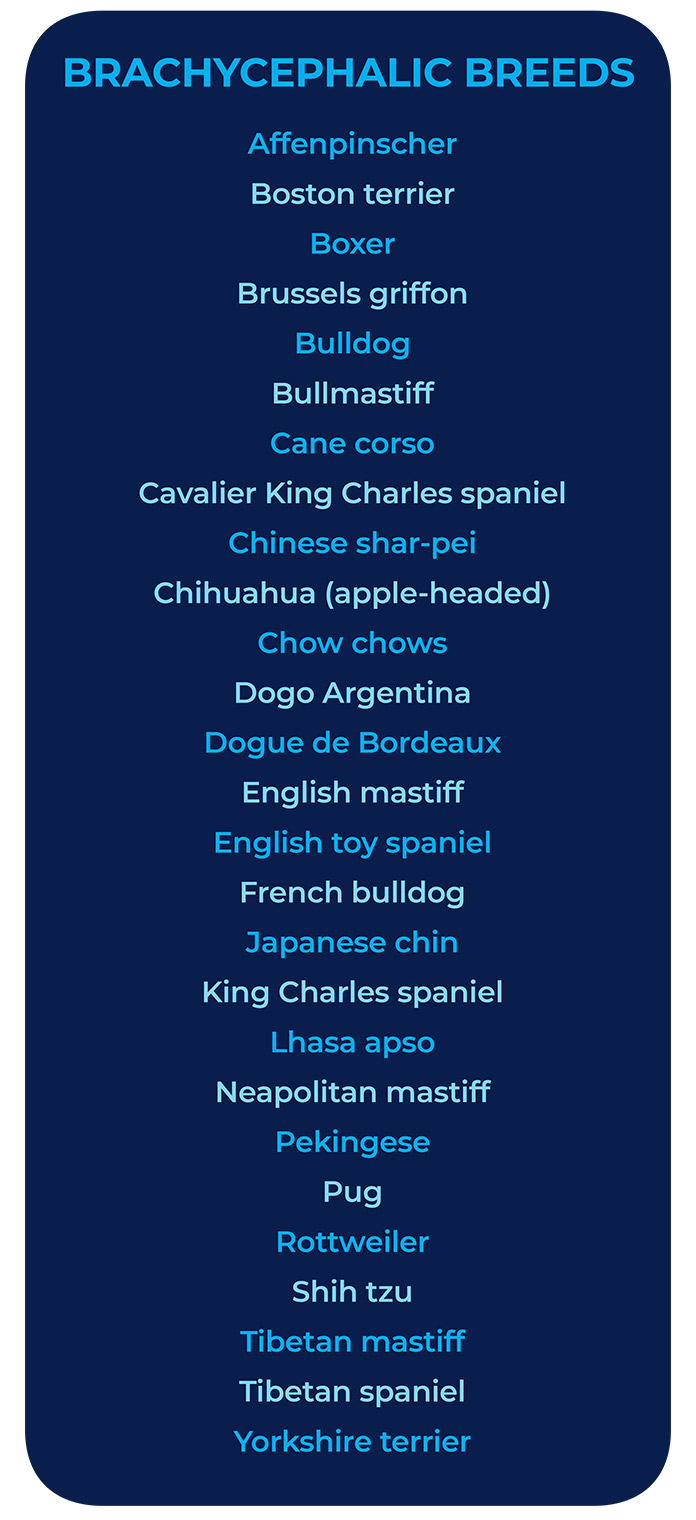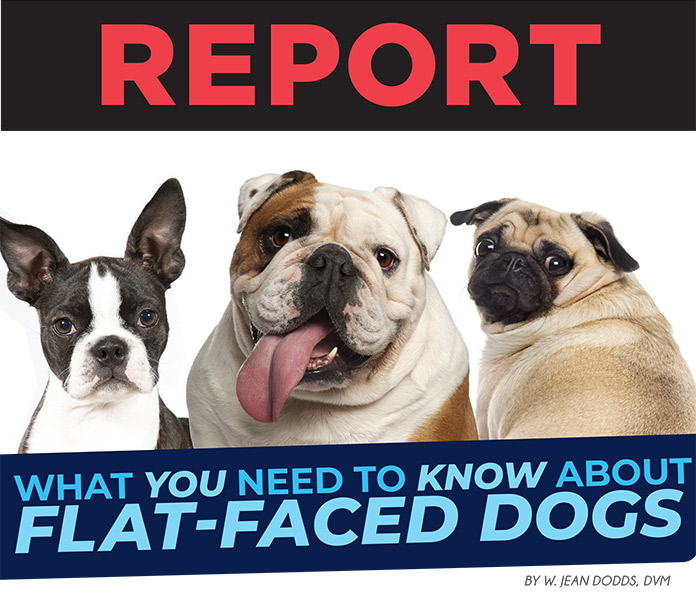From Boston terriers to pugs, flat-faced dogs with short noses are prone to health problems, especially respiratory issues. It’s important to educate yourself about these conditions when adopting a brachycephalic breed or mix.
Many of today’s most popular dogs include brachycephalic breeds such as pugs, Boston terriers and bulldogs. A brachycephalic dog is one with a “shortened head” featuring a short nose and a flat face. In fact, the word “brachycephaly” stems from the Greek root meaning “short” and “head”, and refers to a skull shape that’s shorter than is typical for its species. While brachycephalic breeds appeal to many people, these dogs and their mixes can experience health problems associated with their anatomy and physiology. If you’re adopting a brachycephalic dog, it’s important to know which breeds are prone to these problems and why, and what you can do to minimize issues in your new friend.
WHY ARE THESE BREEDS SO POPULAR?
Among the many reasons we find human babies so adorable are their large eyes and brachycephalic noses and faces. So it follows that people would also be attracted to the appearance of brachycephalic dogs. Recent research has shown that people prefer these dogs for their appearance, which is often prioritized over their health. In fact, the French bulldog is nearly as popular as the Labrador retriever in the UK, with the bulldog not far behind. In the US, the bulldog and French bulldog rank fourth and fifth in popularity.
HEALTH CONCERNS IN BRACHYCEPHALIC DOGS
Veterinary professionals around the world have expressed concerns about the increasing health problems encountered in these breeds. A report from the UK in 2015 reported that upper respiratory disorders were commonly diagnosed in bulldogs, French bulldogs, pugs, border terriers, West Highland white terriers and Yorkshire terriers attending primary care veterinary practices in England. The report stated that the three extreme brachycephalic breed types (bulldog, French bulldog and pug) were relatively short-lived and more predisposed to these disorders than the three other breeds (the moderate-brachycephalic Yorkshire terrier and the non-brachycephalic border terrier and West Highland white terrier).

Meanwhile, research undertaken by Cambridge University’s veterinary medicine group compared the prevalence of brachycephalic obstructive airway syndrome in dogs. They found no prevalence of the disease in a control group of non-brachycephalic dogs, but found it in 40% of bulldogs, 46% of French bulldogs, and 60% of pugs.
These respiratory problems arise from anatomical defects of the shortened upper airway, as well as an elongated soft palate. Brachycephalic dogs are also prone to additional health issues (see sidebar above).
- Symptoms of upper respiratory difficulties include breathing difficulties often associated with overheating, as well as sleep apnea, snoring, snorting and regurgitation. These symptoms progress with age and typically become severe by about 12 months. Some people may consider respiratory issues such as snoring or snorting to be normal for their dogs, and may not seek veterinary intervention until a more severe problem occurs.
- Treatment includes surgical widening of the nostrils, and the removal of excess tissue from elongated soft palates, and any everted laryngeal saccules. Early treatment intervention usually prevents secondary conditions.Potential complications during and after surgery, such as hemorrhaging, pain and inflammation, may make some veterinarians hesitant to perform soft palate correction surgery. With the advent of surgical lasers, however, these complications are greatly reduced.
- Prevention involves limiting symptom aggravation and includes avoiding stress and heat, and maintaining an ideal body weight by not overfeeding. Harnesses should be used instead of collars to avoid pressure on the trachea. As brachycephalic dogs are more likely to die during air travel, they have been banned from flights on many airlines.
If you opt to buy from a breeder, try to find one who selects for more moderate features rather than extremely short or flat faces. Dogs with serious breathing difficulties should not be used as breeding stock, even though many breeders continue to do so; many of these dogs end up at shelters and rescue facilities, so educate yourself about their health problems if you’re adopting. Given the high prevalence of respiratory problems in the most popular brachycephalic dogs, however, removing affected animals from the breeding pool may cause some breeds to become unsustainable. This means out-crossing to non-brachycephalic breeds might become necessary, and would actually be a step in the right direction for the future welfare of these dogs.
If you have a soft spot for pugs, Boston terriers, Shih tzus, or any other brachycephalic breed, don’t despair. Hopefully, as time goes on, recognition of their predisposition to respiratory and other health problems will become more widespread, and breeders will respond by gradually selecting out the features that cause these issues. In the meantime, if you are adopting a brachycephalic dog, whether he’s a purebred or mixed breed, be aware of his potential health problems and do what you can to prevent issues and give your companion a happy and comfortable life.

Dr. Jean Dodds received her veterinary degree in 1964 from the Ontario Veterinary College. In 1986, she established Hemopet, the first non-profit national blood bank program for animals. Today, Hemopet also runs Hemolife, an international veterinary specialty diagnostics service. Dr. Dodds has been a member of many committees on hematology, animal models of human disease and veterinary medicine. She received the Holistic Veterinarian of the Year Award from the AHVMA in 1994, has served two terms on the AHVMA’s Board of Directors, chairs their Communications Committee, and currently serves on the Board of the AHVMF, as well as its Research Grant and Editorial Committees.
[su_button url=”https://facebook.com/AnimalWellnessMagazine” target=”blank” style=”flat” background=”#33bef2″ color=”#ffffff” size=”8″ wide=”yes” center=”yes” radius=”0″ text_shadow=”0px 0px 0px #000000″]Visit our Facebook page for more great content![/su_button]







